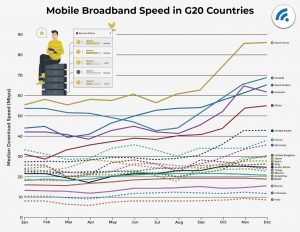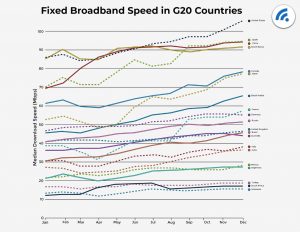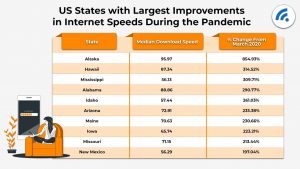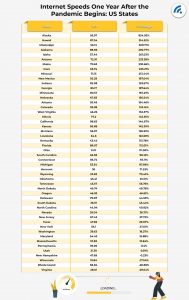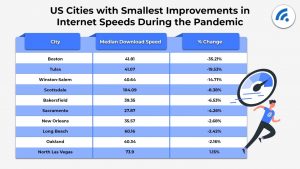«How Has The Internet Held Up During The COVID-19 Pandemic? The Story So Far».
«Originally posted at https://www.broadbandsearch.net/blog/internet-story-covid19-pandemic «
The Coronavirus pandemic that first emerged in winter 2020 has dramatically changed so much about our world. In the spirit of slowing the spread and saving lives, we’ve had to put social events on hold, get used to wearing masks while doing pretty much everything, and adjust to more uncertainty than most of us are comfortable with.
Oh, and now we have to live pretty much our entire lives online.
Most companies and organizations that can have their employees work from home have also done so, and most learning in both schools and universities has gone virtual. Many social events now happen over Zoom or another video call app, and things such as real estate viewings, doctor appointments, and dating pretty much all happen online.
On the one hand, it’s a blessing that we have so much technology to adapt to this reality. Since no one was ready for this, there was a lot of concern that the technological infrastructure we had in place wasn’t strong enough. In other words, there was concern that the pandemic might break the internet.
So, we asked the question: how has the internet held up during the COVID-19 pandemic? Here’s what we found:
The Internet During the COVID-19 Pandemic: At a Glance
Before going into detail about the internet during the pandemic, here’s a summary of our findings:
Overall, after an initial drop, internet speeds have actually increased in most places around the world. This is not universally true, but, in general, the internet has responded well to the increased demand.
Median internet speeds in the United States are around 43 Mbps. In October 2020, this number was approx. 56 Mbps, suggesting some drop-off during the winter, perhaps due to increased restrictions.
The most significant drop came right at the beginning of the pandemic when demand increased so suddenly that many networks were overwhelmed.
There is a disparity. Internet connections are still slower in rural areas and poorer nations, exposing deep inequalities in both American and global society regarding digital access.
Internet Speeds Around the World
As we mentioned, internet speeds around the world have, in general, increased since the beginning of the pandemic. Here’s a snapshot, using data compiled by SpeedTest, of what’s been going on in the G20 countries over the past year as it relates to mobile internet:
South Korea leads the world in mobile internet speeds with a current median of a little under 90 Mbps. The next closest country is Canada.
Interestingly, almost all countries seem to have experienced a similar pattern when it comes to internet speeds. There was an initial drop in March when everyone was sent home, but things quickly rebounded.
Most places seem to have experienced a dip in August. This probably has to do with the fact that many parts of the world, particularly Europe, could return to something that looked like normal in August. In fact, some countries even opened their borders to travelers, which may have impacted mobile internet speeds.
Three great examples to illustrate this are France, Italy, and Spain, traditionally some of the world’s largest tourist destinations. All opened their borders to international visitors, mainly those from Europe, to boost their struggling economies during August. Millions of people flocked there to get away after having spent months in lockdown.
An influx of people from other parts of Europe may have put additional strain on mobile networks, which would explain the dip in performance during August.
Something similar happened in the United States and Canada, although the dip was more of a leveling than a drop. Both countries continued to restrict international travelers during this time, but domestic travel was up. Spending time away from home, where there are fixed broadband connections, stresses the mobile network and can create dips in speeds.
Similar happened in the UK and Germany, neither of which draw the same numbers of tourists as their Southern European counterparts.
Now let’s take a look at what’s been happening with regular, fixed broadband connections:
When it comes to broadband internet connections, we see a very similar story as the one being told about mobile internet connections.
One noticeable difference is that the United States is the leader in this area with a median download speed of over 100 Mbps.
However, we must be wary of this number. 100 Mbps is quite fast, and it represents the middle of the road in terms of speeds experienced around the country. On the ground, there are considerable discrepancies in terms of what people experience in reality.
In general, fixed broadband connections seem to have followed a similar trajectory as mobile connections, though the dips seem to be less dramatic. There was a drop in a few places in August, though it wasn’t as drastic. In general, the only real dip came in March 2020 when stay-at-home orders were first issued, and additional demand was placed on home networks.
Despite these periodic downturns, the overall conclusion we can draw from these numbers is that the internet has not only held up quite well during the pandemic but is improving.
It’s tough to nail down exactly why this is happening, but a lot of it has to do with changes that were already in place before the pandemic. People have been demanding faster internet speeds for some time now, especially as video streaming and other demanding activities increasingly become the norm. In response, internet service providers (ISPs) have improved infrastructure and made faster connections more available to their customers.
It’s also possible that the increase in speeds has driven people to sign up for better plans. ISPs have been offering these plans for some time, but they are more expensive, and people have not been jumping for them. When a faster connection became necessary for both school and work, many people with the means signed up for a better plan, but the critical point here is «those with the means.»
Not everyone has this ability, and this has exposed some harsh truths about our world.
Global Disparities
If you take a closer look at the graphs above of G20 countries, you will notice a few things. One of the more significant is that the countries experiencing the biggest increases in internet speeds are the countries we typically think of as wealthier, more economically-advanced nations.
That the US, Canada, France, the UK, Germany, South Korea, Spain, etc., have been able to boost internet speeds during these times does not come as much of a surprise. People living in these countries are generally speaking wealthier.
So this means they not only have the income to upgrade their connections, but ISPs are also more likely to invest in improving the internet infrastructure in these countries. Wealthier nations have more customers; it’s a simple matter of investors.
Therefore, we should be cautious about saying that these numbers indicate we are moving in the right direction. Nations such as Indonesia, Mexico, India, Argentina, South Africa, and Turkey all experienced little to no increase in internet speeds. In some cases, such as in Turkey, they experienced a slight decrease throughout the pandemic.
Looking Beyond the G20
The graphs above are made up of numbers from the G20 countries, which comprise the world’s 20 largest economies. This means that if we want to get an accurate image of what is going on in the world as a whole, we need to expand our scope. When we do this, we find that:
Only about 30 countries have median download speeds above 25 Mbps. The FCC (based out of the US) says that a connection must have at least 25 Mbps to be considered broadband. This means that the vast majority of the world, while connected to the internet, relies on subpar connection speeds.
The countries with the fastest internet speeds that aren’t part of the G20 are small, wealthy nations. For example, Lichtenstein has the best internet globally, with median download speeds of around 187 Mbps. They are followed by Denmark, Switzerland, Hong Kong, Sweden, Andorra, Bermuda, Luxembourg, the Netherlands, and Finland.
Some 150 nations worldwide have median download speeds of less than 10 Mbps, most of which are located in Asia and Africa. Within that group, around 50 countries have median internet speeds of less than 2 Mbps, which means they basically don’t have internet access at all.
In these countries where the internet is already relatively slow, connection speeds have not been significantly impacted by the pandemic. This is probably because these countries’ economies are still mostly rural, meaning they don’t rely on the internet.
Any restrictions put in place did not result in large numbers of people working from home. Of course, this is a broad generalization, but if internet speeds were already extremely slow, it’s likely that much of life was already taking place offline.
However, these numbers show that while internet speeds increase in the wealthy parts of the world, even with all this extra demand, large swaths of the global population are being left behind. Every day, the world moves more and more online.
Getting an education, searching and applying for jobs, and now day-to-day working all demand a solid and stable internet connection. Therefore, in countries where the internet is not good, people are being denied the opportunity to enter the modern economy and take advantage of all it offers.
While we should be glad to see the internet holding up and improving in many places, we should also keep in mind that there is still lots of work to do to close these gaps and ensure everyone has an equal chance to participate in our increasingly globalized and digitized world.
Internet Speeds in the US
After looking at global data, we can see that the internet has held up reasonably well during the pandemic. More so in some countries than in others. The United States is fortunate to be one of those nations where internet speeds have been steadily improving (despite some periodic drops) over the past year.
We need to take a deeper look at some of the US numbers to understand better what is happening and where our attention needs to be focused moving forward.
By State
To start, we took a look at what is happening on a state-by-state basis. Here is some of what we found:
On average, across all 50 states, internet speeds have increased by an average of 123% since the beginning of the pandemic.
46 out of 50 states saw an increase in their internet speeds during the pandemic, with just four (New Hampshire, Wisconsin, Rhode Island, and Virginia) experiencing a decrease in speeds.
The most significant average increase in speeds came in August. Overall, the increase was 58 percent, but some states, such as Alaska (93 percent increase) and Hawaii (89 percent increase), did much better than this.
After August, the months in which there was the biggest increase were April (57 percent) and June (15 percent). The April jump came as internet speeds stabilized after an initial drop due to the imposition of lockdowns and stay-at-home orders. In June, the increase was possibly due to schools being let out. There was less demand on connections, something that tends to happen in the summer anyway.
To dig a bit deeper, here is a breakdown of the states that have done the best during the pandemic when it comes to internet speeds:
As you can see, these states have done remarkably well during this time. It’s interesting to see such dramatic rises because some of these states are quite rural, which typically means slower connection speeds. Part of the reason things may be going so well is that because these states are rural, there are fewer digital economy workers, meaning less added stress on connections than we saw in other areas.
As many of these states started the year with very slow internet connections, so they had lots of room to grow.
That these states are more rural is heartening because it means progress is being made to reduce the digital divide between the country’s urban and rural states.
Now let’s take a look at the states that did the «worst» during the pandemic.
States With Smallest Improvements
Here we see almost the complete opposite. These states are all quite urban, and in many cases, quite densely populated. Therefore, when people were forced to work/go to school in their homes, there was a great deal of extra stress placed on these states’ tech infrastructure.
The obvious exception to this is New Hampshire, which we typically think of as a rural state. Yet, given its proximity to Boston, it’s likely that workers set up shop in the more relaxed environment of The Granite State while forced to work from home, putting stress on the state’s networks.
However, while these states struggled a bit during the pandemic, six of the ten still saw an increase in internet speeds. All of these states have median download speeds higher than the 25 Mbps threshold established by the FCC, which is a good sign.
Of course, it would be interesting to dig deeper into what’s happening in states such as Pennsylvania, Utah, Virginia, New Hampshire, and Washington to see if these improvements were experienced by people living outside the major urban areas in these states.
Internet Speeds in all 50 States During the Pandemic
Want to see how your state fared over the past year? Here’s a list of all 50:
Internet Speeds in the 100 Largest Cities in the US
To answer the question of how the internet has been holding up in the pandemic a little bit better, we dug into the numbers in the 100 largest cities in the US. Here’s a summary of what we found:
On average, cities saw a 35 percent increase in median download speeds throughout the pandemic, which is considerably smaller than what we saw at the state level (123 percent.) This is mostly due to population density. A state as a whole might have seen an improvement, but those improvements may have come in rural areas. In more urban areas where there are likely to be more people working from home, the increase was not as significant.
A total of nine cities saw internet speeds decrease during the pandemic. The biggest improvement was in Kansas City (168 percent)
The largest jumps in improvement came in June (16 percent) and August (14 percent). The story on the state level was similar, though the improvements in cities were once again more modest. This may have to do with both lifting restrictions in the summer and the school year. Many large cities started their school years remote, and this likely put additional strain on the internet and slowed down speeds.
Let’s take a look at some more specific city-level data:
Cities With Largest Improvements in Internet Speeds
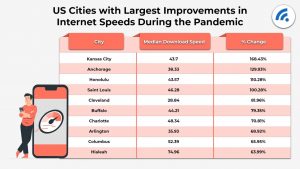 Anchorage and Honolulu are the capitals of Alaska and Hawaii, respectively. Both states experienced the most significant increase in internet speeds throughout the pandemic, so there’s not much surprise here.
Anchorage and Honolulu are the capitals of Alaska and Hawaii, respectively. Both states experienced the most significant increase in internet speeds throughout the pandemic, so there’s not much surprise here.
As for the rest of the cities, the only noticeable trend is that they are smaller-sized urban areas. Being less dense may have helped internet connections improve despite the increased demand.
However, this may not be true. Some of the country’s largest cities – New York (34 percent), Chicago (32 percent), LA (34 percent), Phoenix (35 percent), and Philadelphia (42 percent) – all experienced modest increases in speed. This may be because these cities already had reliable infrastructures in place, mainly because they are large urban areas with lots of consumers able to spend on better connections.
Cities With Smallest Improvements in Internet Speeds Improvement
Here’s a list of the ten cities that experienced the smallest improvement in internet speeds during the pandemic so far:
As you can see, except for North Las Vegas, all of these cities saw a decrease in median download speeds. In general, these cities are much larger than those at the top of the list, but we’ve already mentioned that might not be the best way to explain this phenomenon.
That Boston saw the biggest decrease is also quite surprising, especially considering the large tech industry there.
One thing to consider is schools. Many large cities tried to begin the new school year with in-person learning, but some opted for full-remote or were forced to switch to full remote soon after opening. This may have had some impact on the slowdowns, but it’s likely not the only reason. There must be another explanation that will be the focus of another study.
Here’s the complete list of all 100 cities included in our study so that you can find out how things have changed in your area:
Internet Access for the Poor
Although the numbers presented here are certainly encouraging, we need to be wary about saying this means there are no problems with internet speeds and access across the United States.
Overall, around 18 million people in the US lack access to reliable broadband internet, and the primary reason is money. In other words, they simply can’t afford it. There are also racial inequalities exacerbating this problem.
If nothing else, the Coronavirus pandemic has shown that the internet is essential for life. Not having reliable access to it can seriously impact a person’s ability to advance themselves and participate in society.
Therefore, while internet speeds do seem to be improving across the board, and despite the increased demand the current situation has placed on our networks, we should not take this to mean that our work is finished. There’s still lots more to do.
Conclusion
When the pandemic first broke out in February/March of 2020 and everyone was sent home, many people doubted if the internet was up to the task. While initial slowdowns made it seem like this was indeed going to be the case, download speeds have bounced back in a big way.
This is promising as it shows how web connectivity is improving around the world. Yet, it also serves as a reminder that we can rise to challenges when we need to. It’s essential to take this perspective moving forward as the world restores some sense of normalcy and tries to move beyond the madness that has been the CoOVID-19 pandemic.
